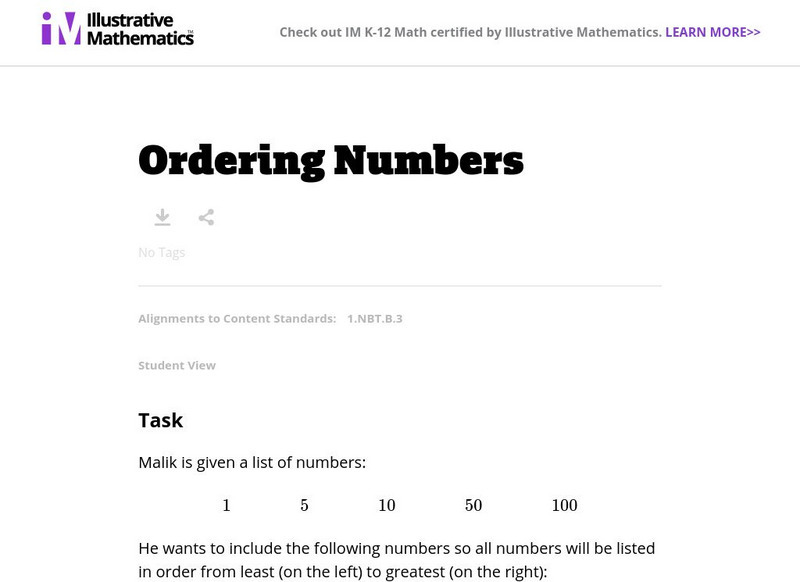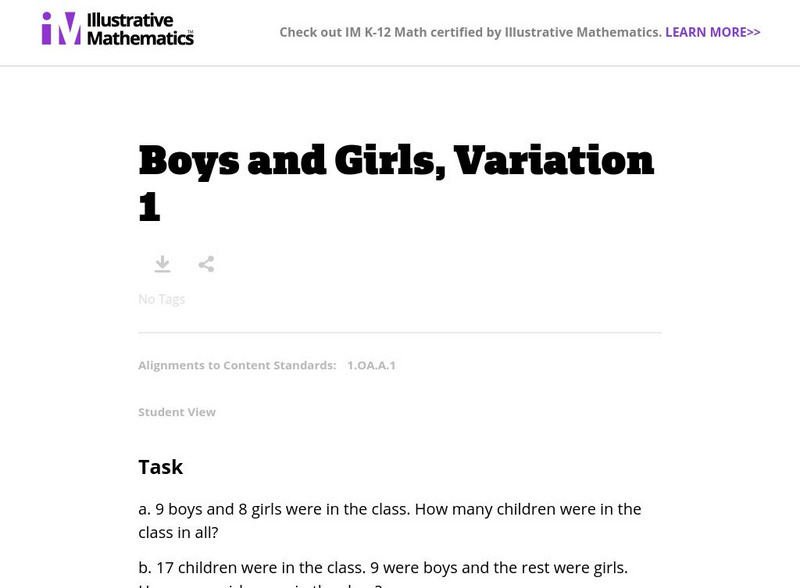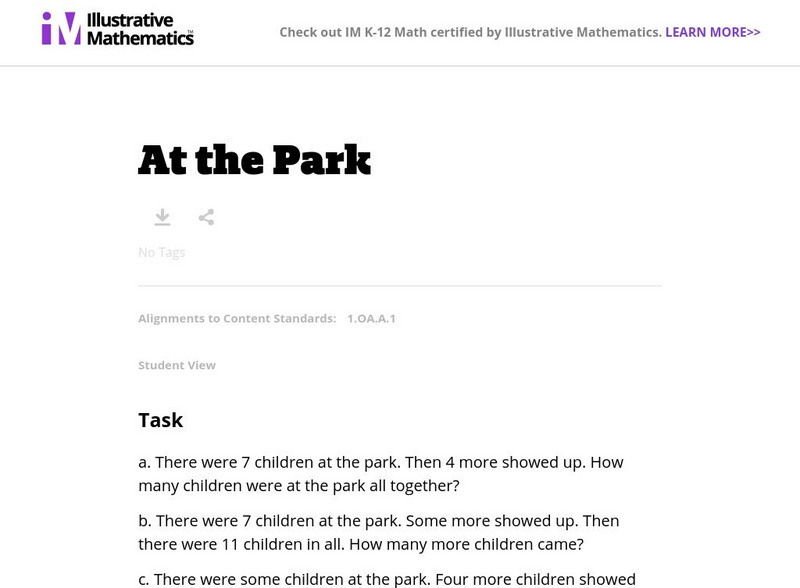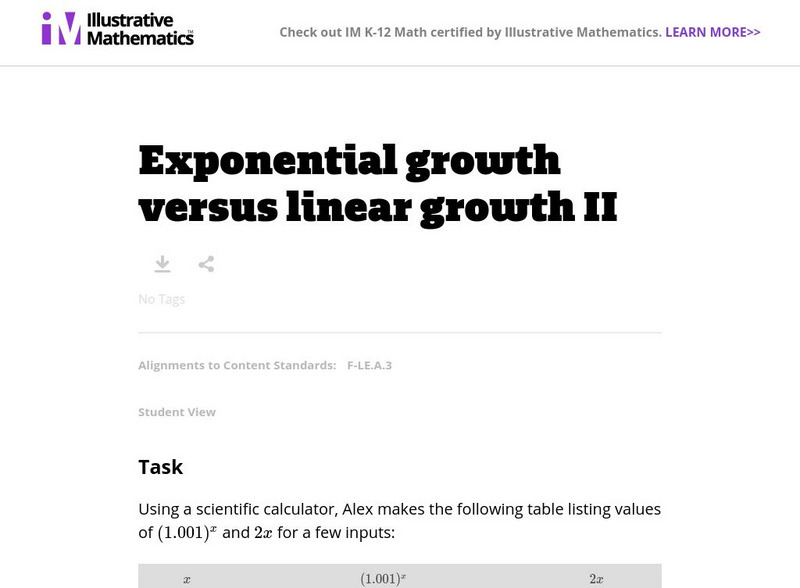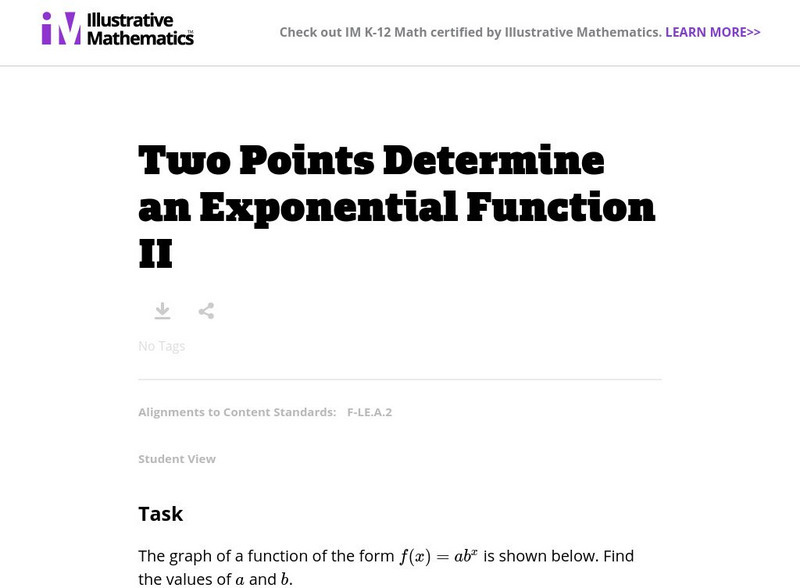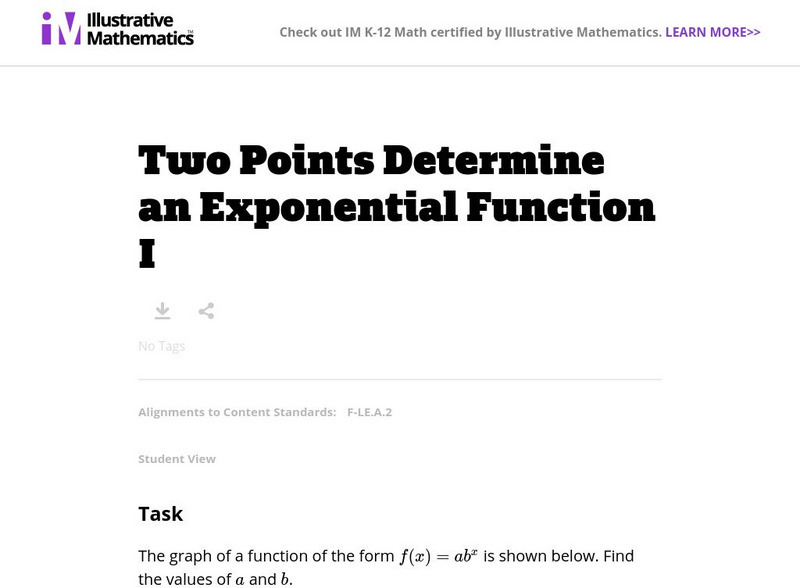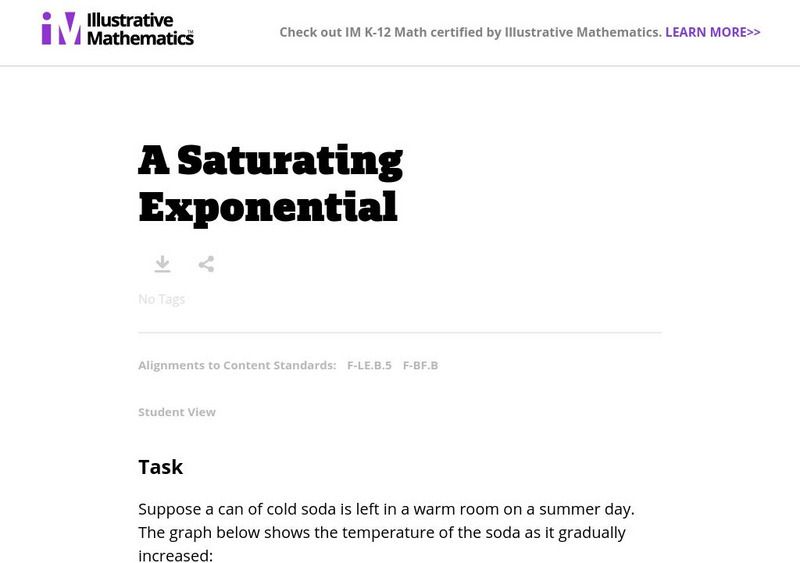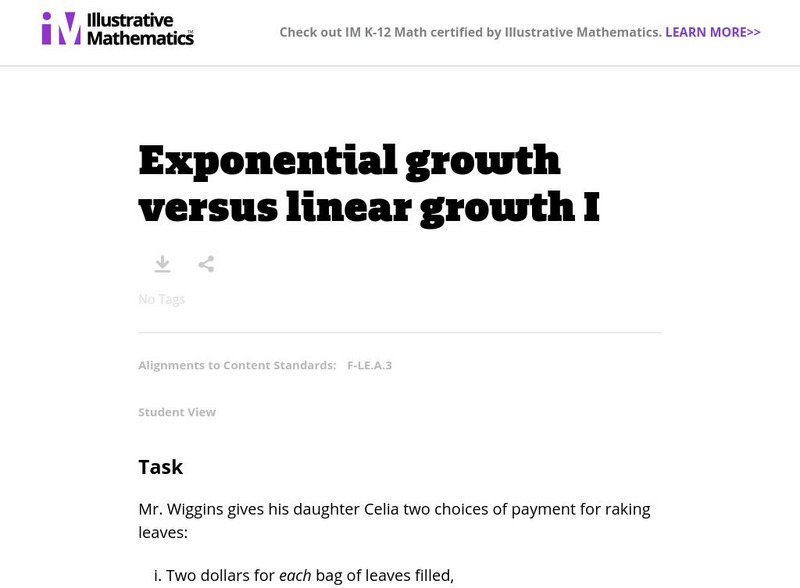Illustrative Mathematics
Illustrative Mathematics: Start/stop Counting Ii
Learners will practice counting to 120 forward and backward with this whole class game. The teacher will give a counting sequence (for example, 20-120) to the students who will be seated in a circle. The teacher will begin walking around...
Illustrative Mathematics
Illustrative Mathematics: Hundred Chart Digit Game
Students will practice identifying two-digit numbers with this game which utilizes a 100 chart. Instructions, materials needed, and variations are included in this lesson.
Illustrative Mathematics
Illustrative Mathematics: Counting Circles Ii
Young scholars will stand and form a circle facing in toward each other. The teacher will select a counting sequence to be practiced with no more than 6-10 numbers. The students will start counting around the circle one by one until the...
Illustrative Mathematics
Illustrative Mathematics: Ordering Numbers
Given a set of numbers, students need to decide where to place another set of numbers so they are ordered from least to greatest. This is a good precursor to greater than/less than. A detailed example is included.
Illustrative Mathematics
Illustrative Mathematics: Crossing the Decade" Concentration
This game is a version of the traditional memory or concentration game and will help students practice "crossing the decade". A detailed explanation of the rules, materials needed, and variations are included in this lesson.
Illustrative Mathematics
Illustrative Mathematics: Boys and Girls, Variation 2
Learners are asked to solve a word problem with both addends unknown. They will write an equation and draw a picture to use to explain their answer.
Illustrative Mathematics
Illustrative Mathematics: Boys and Girls, Variation 1
This word problem focuses on the Put Together/Take Apart contexts for addition and subtraction. Students may use objects, pictures, or equations to represent their solutions. Examples and explanations are provided.
Illustrative Mathematics
Illustrative Mathematics: At the Park
Students will solve a variety of word problems with differing levels of difficulty. They may use objects, pictures, or equations to represent their solutions.
Illustrative Mathematics
Illustrative Mathematics: 20 Tickets
Students are given a word problem with multiple solutions. They are challenged to solve the problem using manipulatives, to draw a picture to represent their work, and possibly record their responses using equations. Examples of...
Illustrative Mathematics
Illustrative Mathematics: 6.rp Price Per Pound and Pounds Per Dollar
Young scholars use ratios to answer four questions about rate and pounds in this performance task.
Illustrative Mathematics
Illustrative Mathematics: 6.rp Hippos Love Pumpkins
Students use ratios to answer four questions about rates in situations involving unusual units in this performance task.
Illustrative Mathematics
Illustrative Mathematics: F Le Bacteria Populations
This task provides a real-world context for interpreting and solving exponential equations. Students are asked to examine the equations representing the growth of three colonies of the bacterium that causes pneumonia, each colony being...
Illustrative Mathematics
Illustrative Mathematics: F Le Carbon 14 Dating
The task requires the student to use logarithms to solve an exponential equation in the realistic context of carbon dating. Aligns with F-LE.A.4.
Illustrative Mathematics
Illustrative Mathematics: F Le Exponential Growth Versus Linear Growth Ii
In this task, students compare exponential and linear functions and find that exponential functions with a base larger than one eventually exceed in value any given linear (or polynomial) function if the value of the input is...
Illustrative Mathematics
Illustrative Mathematics: F Le Two Points Determine an Exponential Function Ii
In this task, students are shown a graph of an exponential equation, with two points labeled with their coordinates, and are asked to find the values of a and b in the equation. Aligns with F-LE.A.2.
Illustrative Mathematics
Illustrative Mathematics: F Le Two Points Determine an Exponential Function I
This is a simple task where students are shown a graph of an exponential equation, with two points labeled with their coordinates, and are asked to find the values of a and b in the equation. Aligns with F-LE.A.2.
Illustrative Mathematics
Illustrative Mathematics: 6.rp Riding at a Constant Speed, Assessment Variation
Students use ratios to answer four questions about rate and distance in this performance task.
Illustrative Mathematics
Illustrative Mathematics: F Le What Functions Do Two Graph Points Determine?
In this task, learners find a unique linear function, a unique exponential function, and more than one quadratic function that go through the same two points on the coordinate grid. Aligns with F-LE.A.
Illustrative Mathematics
Illustrative Mathematics: F Le Algae Blooms
This problem examines the growth of algal blooms in Chesapeake Bay. Students build an exponential function modeling algae concentration based on the information provided, and gain an appreciation for the exponential growth exhibited...
Illustrative Mathematics
Illustrative Mathematics: F Le Do Two Points Determine a Linear Function Ii?
In this task, students investigate the relationship between linear equations and linear functions. Aligns with F-LE.A.2.
Illustrative Mathematics
Illustrative Mathematics: F Le a Saturating Exponential
For this problem, students use an exponential equation to investigate the warming up of a cold beverage on a summer day and analyze a graph to estimate temperatures. Aligns with F-LE.B.5 and F-BF.B.
Illustrative Mathematics
Illustrative Mathematics: F Le Exponential Growth Versus Polynomial Growth
In this problem, students compare the growth of exponential functions versus polynomial functions and find that an exponential function takes larger values than a cubic polynomial function provided the input is sufficiently large. Aligns...
Illustrative Mathematics
Illustrative Mathematics: F Le Exponential Growth Versus Linear Growth I
In this task, students analyze two methods of payment to discover how an exponentially increasing quantity eventually surpasses a linearly increasing quantity. Aligns with F-LE.A.3.
Illustrative Mathematics
Illustrative Mathematics: F Le Do Two Points Always Determine a Linear Function?
For this task, students explore linear functions and whether they can always be determined by two points on the coordinate grid. It focuses on producing an explicit function f(x) in the case where the line is not vertical. Aligns with...





